Chapters
Chapter 8. Politics and the Public Sphere
News, Pamphlets and Revolution
The use of printed material to create public discourse can be tracked to the ballads and newssheets that appeared in the 16th century. The oldest known English newssheet recorded the events of the Battle of Flodden Field, at which the British armies under Henry VIII defeated the Scottish forces, killing their king, James IV.1 The broadsheet is illustrated with a woodcut, printed in a black-letter font, and written in Renaissance English, which contains conspicuous influences of both French and Anglo-Saxon in its orthography. Official newssheets were circulated in China centuries earlier, where there was a well-established pattern of the imperial court issuing annual government reports in the early centuries of the Common Era. These were handwritten documents, as were early “avvisi” (advisings) in Europe in the 15th and 16th centuries, but the use of printed sheets to report scandals and notable events began in earnest in the 16th century.2 Murders and murderesses, hangings and punishments, and other events deemed sufficiently entertaining to tempt the population to part with the price of the sheet featured in these sensational ballads (many scandalous tales were rendered in verse) and broadsheets. [Figures 1a and 1b]
Other purposes were also served by news publications: the communication of events in the courts and parliaments of other nations, discussion of treaties and their terms, any number of matters affecting diplomacy and international relations. In addition, business news commanded considerable interest, with information about prices for goods and materials, as well as tariffs and taxes. As colonial expansion continued, the news of shipping loads arriving with their goods and the timing of ship passages and transits was circulated in newssheets as well.3 The company Lloyd’s of London engaged in publication of “shipping news” on a regular basis to serve their own interests and that of their clients, whose ensured goods were part of their concern. Postal networks were also established in Europe and England in the 16th and early 17th century, and made a new contribution to literacy as a phenomenon in which time-sensitive information could pass rapidly from spot to spot.4 This was particularly important in political matters, but as these affected business as well as trade and some aspects of intellectual life, they changed the way information in printed materials was used to inform and create a “public”.
But the concept of the public sphere, implied by these modes of publication, and as understood by the 20th-century philosopher Jürgen Habermas, becomes charged with a very different level of political potency as theories of forms of government and human rights started to change in the 17th century.5 These had substantial consequences for the destabilization of the power of monarchical regimes in the 18th. Literacy serves political purposes in addition to those of study, worship, entertainment, diversion, or education and becomes a means of creating an image of the “people” and of their capacities and rights.6 The consensual understanding of forms of government and individual identity shifts as a result, and a broader public and more engaged populace makes use of printed materials for these new purposes. In particular, printed matter had a crucial role to play in the development and spread of Enlightenment thought, political philosophy, and in the American and French Revolutions. As it had in the Reformation, the English Civil War, and other major events of the 16th century, so printed matter served as both an agent and a record of social change in the 17th and 18th centuries.
During this period, all printed matter was still made within the technological specifications that had been developed by Johan Gutenberg. Every piece of type was still cast from a matrix struck by a punch that had been carved by hand, and every page was composed letter-by-letter with handset type. It is estimated that by the 17th century, a press could produce more than three thousand copies of a single sheet in the course of a working day—about three hundred copies an hour, or five a minute, which is remarkable (this does not include the time for setting and distributing type).7 When automated presses were first developed in the early 19th century, the initial purpose to which they would be put was newspaper production. Other assists to mass production and multiple form creation arose in advance of actual machine power, and these combined would alter printing radically. But in the meantime, print would help bring about a new world and changed forms of government as well as expectations about the role of the state in the lives of governed beings. [Figures 2a and 2b]
Public Sphere, Politics, Pamphlets and News
As with other changes in technology, the coming of newspapers did not happen in isolation. Changes in trade and commerce, banking and shipping, accumulation of wealth and the traffic in goods and raw materials from the colonies of European and British governments all played a role. Among these goods was coffee, which, along with chocolate, was served in coffee houses where newspapers were also available.8 The first known coffee house in Europe was opened in Venice in the 1640s, but the popularity of the drink spread rapidly. The sociality and conversation produced under the stimulation of caffeine were mocked by satirists in broadsheets that mimicked the perceived inanities of constant exchange—the social media of the day. But coffee houses served as places to develop shared ideas and create a public discourse around the topics of the era. The 18th century witnessed many changes in attitudes about libel, free speech, and rules governing the press and the proliferation and reading of newspapers was part of these changes. The concept of public opinion expanded, and whether the political force generated can be considered illusory or real, mythic or actual, depends on what specific events are being debated. But that the role of printed matter, and its sites of use, became far more public in the 17th and 18th centuries is clear. For instance, the Café Procope in Paris is considered the spot where the Encyclopédie may have been conceived, since it was frequented by the influential philosophers who contributed to its development: Voltaire, Rousseau, and Diderot.9 Coffeehouses were places of business as well as debate and discussion, and as they proliferated in the 1740s and 1750s in London, for instance, they acquired individual character according to the political disposition or occupation of their clientele.
The 1621 Corante is given credit for being one of the first English newspapers, but the development of a genuine newspaper publishing took some time.10 Basic features such as the masthead, columns, headlines, and regular serial publication emerged across the 17th century.10a While political interests served to stimulate reporting, mercantile concerns commanded the front page of many newspapers with their accounts of goods and shipping. The creation of journalistic style required thinking of writing in ephemeral terms, as well as traditional literary ones, and Joseph Addison and Richard Steele´s The Spectator, first published in 1711-12, embodied the art of commenting on the passing scene with elegance and flourish.11 Names for early newspapers, like The Observer or The Monitor, also provide a clue to the role such sheets were meant to play.
American Newspapers
In the American colonies, newspapers were to be published only on “authority,” or, subject to licensing and approval. The first colonial newspaper, Publick Occurrences both Forreign and Domestick, was published in 1690 by printer Benjamin Harris.12 As he had failed to obtain license from the local Governor, the paper lasted exactly one issue, and then was closed down and the copies destroyed. Only a single exemplar is known, held by the British Library. But the story shows how dangerous printing equipment appeared to be to the authorities. The text of that issue makes fascinating reading, compressing, as it does, accounts of native encounters, attacks, skirmishes at home and abroad, breakout of diseases, and all manner of other events of interest.
In 1704, The Boston News-Letter began regular publication, and, like other colonial papers that followed, it was subject to approval by the local governor.13 The paper stayed in business, changing focus from news of England and the Continent, to activities in the Colonies, up until 1776. While its editorial policies remained loyal to the British crown, the habits of reading and of absorbing public opinion established early in the colonial period laid a foundation for debate and dissension. From a single newspaper in regular publication in the colonies in 1713, the number went to twenty-three by 1765, with papers being issued in runs of 700-3000 copies.14 The estimate is that a 4-page sheet could be composed in type in about sixteen hours, so the weekly paper or even bi-weekly was realistic.
Early publishers tested legal limits on the as-yet-undefined concept of freedom of the press. In a landmark case in 1734, the editor of the New York Weekly Herald, Peter Zenger was accused of libel for criticizing William Cosby, the local governor, for his attempt to give himself a raise.15 His lawyer, Andrew Hamilton, was able to argue for his acquittal on the grounds that “truth is an absolute defense against libel.” He was judged not guilty, and the precedent was established.[Figure 3]
As dissent increased in the American colonies in the 1760s and 1770s, printers were vulnerable to acts of repression since their shops, including their presses, type, paper, ink and other supplies, were readily located and confiscated or destroyed if they were found to be engaged in printing what came to be known as seditious material. The practice of pamphleteering, making polemical statements, especially during tumultuous periods, was best done anonymously, separating author from work and printer from association. Furthermore, printing that appeared without a printer’s name was illegal, and left the printers open to accusations if work could be tracked to their shop.
Pamphlets, generally printed as multiple pages in a form on both sides of a single sheet of paper, were a popular means of disseminating opinion.16 The colonial environments were small communities, and attacks fostered by one faction against another resulted in discord and also litigation. Local officials were also often subject to attack, though prominent figures, like the prolific preacher Increase Mather, also used print to express judgments and opinions in the 1690s and 1700s, in making a case against the Quakers for their religious beliefs.17
Almanacks were one of the staples of the printing trade, though contracts with colonial governors also provided income for printers. Benjamin Franklin’s Poor Richard’s Almanack began publication in 1732 and was published continually by him for more than a quarter of a century.18 Almanacks contained a wide array of useful information including calendars, cures, advice on planting, cycles of the moon and stars. Franklin also freely adopted the aphorisms of others while adding his own advice on living well and wisely to the mix of sayings and proverbs in his small almanacks. His success and popularity were based on the platform provided by printed matter.
Isaiah Thomas the first American historian of the book, born in 1750, was illiterate at the time he began setting type as an apprentice.19 But his newspaper, The Massachusetts Spy, founded in 1770, was one of the most successful colonial newspapers, with a wide circulation and an outspoken advocacy of Independence. As a bookseller, printer, and publisher, he became wealthy and influential in the first decades of the early American nation. His 1810 volume, The History of the Book in America, remains a milestone in the field.
Intellectual life and political philosophy
Many crucial ideas became popular in the political philosophy of the early 18th century. These notions are associated with rational thought applied to theories of government, but also, with desires to reinvent the democratic ideals of ancient Greece and the Roman Republic as a basis for modern government. The work of Montesquieu (full name, Charles-Louis de Secondat, Baron de La Brède et de Montesquieu), a French philosopher who articulated the separation of judicial, executive, and legislative branches of government, exerted a major influence on the conceptualization of the Enlightenment experiment that is American democracy.20 [Figure 4] The limitation of monarchical power had already began to take hold—the British Restoration of Charles II had inaugurated a constitutional monarchy, rather than returning absolute power to the throne following the so-called Glorious Revolution. Montesquieu’s De L’Esprit des Loix, (On the Spirit of The Laws) first published in 1748, was among the most cited works in the debates unfolding in colonial America because of its theory of government.
In this era of the philosophes, many serious thinkers were attempting to formulate a working model of democracy. John Locke’s Second Treatise of Government, published in 1689, argued for certain inalienable rights for human beings.21 Thomas Hobbes, in Leviathan (1651), had suggested that a society without government would be brutish, with no protections and no civility. [Figure 5] This edged toward the understanding that the relation between people and their government allowed an agreement to submit to authority in exchange for certain benefits—a preliminary notion of what was outlined by Locke and then stated fully in Jean-Jacques Rousseau’s 1762 Du Contrat Social. He believed that government and laws are human creations, not natural, and thus can be shaped by reason and understanding.22 Citizens enter into an agreement to be governed in exchange for giving up certain freedoms (e.g. the right to grab land at will) and gaining benefits in return (protection of private property).
The idea that government was not natural seriously undermined the concept of the divine right of kings, an idea that was a legacy of medieval times. For the colonists in America, the question of self-governance was in considerable part raised by resistance to taxes imposed by the British to help defray costs incurred in the Seven Years’ War (1756-63). These included the infamous Stamp Act imposed on paper in 1765 and the Townshend Revenue Act of 1767 taxing such items as tea, glass, paint, lead, and other goods essential for sustaining life and developing livelihoods in the colonies. While ostensibly a revenue-generating move, the Stamp Act had the unfortunate effect of inflaming sensibilities by seeming to make publication more difficult and thus stifling dissent. Other taxes, on tea for instance, brought about their own protests from colonists who resented the fact that they had no elected representation in the British Parliament. Printed pamphlets and newspapers helped spread dissent as well as foster debate across the full spectrum of political opinions.
Pamphlets and the War of Independence
Restlessness in the colonies and debates about the rights of self-governance were met with opposition in the publications of loyalists in England and in America. Of the dozens of pamphlets published in the third quarter of the 18th century as part of the conflicts, a handful are particularly well-known for their widespread influence. Some, as Bernard Bailyn and Jane Garrett noted in their 1968 edited volume of these documents, made substantial contributions to the formulation of the Constitution, others were intriguing for the fierceness of their language and passion of their stance.23 A number of these publications had literary merit, and in keeping with the temper of the times, these political tracts took all kinds of forms-sermons, poems, dialogues, essays, letters, and so forth.
Among the most renowned is the 1767 pamphlet authored by John Dickinson titled “Letters from a Farmer in Pennsylvania.”24 The rhetoric of this text, like others of the period, not only allowed concerns to be aired, but worked towards consolidating an idea of new nation in the public mind. This action fostered considerable shared understanding and helped make concrete an idea of an American nation that had no solid base until the War of Independence was completed. British laws, meant to repress the latent uprising, actually polarized factions and created more dissatisfaction among the colonists. Dickinson’s first letter was published in a newspaper, The Boston Chronicle, on December 21, 1767. Dickinson’s tone is considered moderate, but his continued campaign of thirteen letters inflamed public opinion against the British on the basis of charges that they were wrongfully depriving the colonists of their rights.25 Dickinson’s identity as a farmer was important in light of the political arguments suggesting that if a Republic were to replace a monarchy, its integrity and success would depend upon its being run by men of virtue. This phrase meant male citizens who knew the value of hard work, were honest, and were not hereditary aristocrats with unearned privilege. Thus the image of an ideal “American” citizen was formulated in the public mind through printed texts. The men who were to assume power were represented by this farmer, not an aristocrat or landed gentry, not a member of a royal family given power by divine right, but a person drawing sustenance from the soil of his newly colonized land through hard work and honest labor. This mythic ideal was broadly embraced, brought to the fore through Dickinson’s authorship. [Figures 6a and 6b]The pamphlet went into ten editions and circulated widely, though neither its numbers nor its popularity came close to the main bestseller of the era, Common Sense, by Thomas Paine, first published in 1775-76.26 [Figure 7]
The political questions that drove the War of Independence were philosophical in character, not just political. Though freedom from taxation and other forms of exploitation or oppression was an essential goal, the terms on which a new democratic government could be set up and succeed were grounded in ideas about what was politically possible, and correct. The idea of a “common” or “shared” understanding of human rights and capabilities was one of these ideas. Tellingly, the series of letters that Paine composed, and which became the incredibly popular and inflammatory pamphlet, was originally titled “Plain Truth.” The switch to “Common Sense” indicates the shift towards invoking a body politic along with a concept that could be universally understood as an almost self-evident notion. This notion of a “sense” as a natural perception that could be agreed to by all and thus deemed “common” aligned Paine’s thinking with that of Enlightenment figures like Rousseau, who sought to establish the “natural” rights of “man” in similar terms. Twenty-five editions and half a million copies are estimated to have been produced in the first year of publication of Paine’s pamphlet. The text is a treatise on government, a condemnation of the British monarchy and its aristocratic system, a proposal for a new form of colonial government, and an examination of the readiness of the American military. Paine’s writing style was direct and effective with audiences as he outlined the abuse of power and rights of common people to defend themselves against them. Paine and his text were the subject of mockery and satiric imitation, including unflattering graphics and portraits, and, again, print media played an important role in the circulation of these adversarial opinions. But his influence would not be surpassed.
The text of “Declaration of Independence,” was composed in Philadelphia and ratified on July 4, 1776.27 A bold and daring document, from which there could be no turning back, it too was informed by Enlightenment philosophy and conviction in equal measure by figures who held the ideals of Greek democracy and the Roman Republic in high esteem. The first printed version of the document was a broadside, created in John Dunlap’s shop in July 1776, likely from a clean source copy that was discarded.28 The handwritten version of the “Declaration,” preserved in the National Archives, was actually produced later, and most of its signers put pen to vellum on the 2nd of August 1776. Though the handwritten version is the iconic image, the printed broadsheet is the authentic first publication and appearance of the document, which was circulated widely.
French Enlightenment Publishing
If printed matter served the colonies in creating a propaganda war in support of their war of independence, the press was at least as powerful in the many political activities of the Revolution in France that overturned the monarchy, introduced the Terror, and was followed by the rise of Napoleon and his eventual self-installation as Emperor.
In the Ancien Régime, as the pre-Revolutionary government is known, publishing flourished among elites. Multi-volume books included classics, scientific works, novels, legal texts, poetry, tales of adventure, humor and history elaborately printed and hand-bound for private libraries and limited readership.29 In the French Enlightenment, begun in the late 17th century, an enormous intellectual confluence of philosophical and literary prowess occurred. The quintessential Enlightenment project, published over a twenty year period between 1751 and 1772, was the Encyclopédie ou dictionnaire raisonné des sciences, des arts et des métiers.30 Denis Diderot was one of the editors and his attitude was that all things had to be looked at, examined, and investigated and that regard for sentimental feelings or religious restraint had no place in an intellectual undertaking committed to the systematic presentation of human knowledge. As a publication, the seventeen volumes of articles and eleven volumes of illustrations, totaling 75,000 entries in 18,000 pages of text (about twenty million words in all), is a masterwork of production. The plates are a veritable inventory of technological knowledge of the trades, agriculture, natural history, military materials, weaving, furniture production and so on. The rational presentation of information, demonstrated in the overview diagram of the entire project, was meant to reflect the order of knowledge as well as the rational structure of the world. These deep convictions were radical in their time, and though other encyclopedic volumes had appeared in medieval manuscript and Renaissance printed works, nothing had been attempted at this scale or comprehensiveness. The Encyclopédie is a veritable inventory of knowledge of the time, comprehensive in content, and “reasoned” in its organization of theoretical and applied knowledge.
Jean-Jacques Rousseau was a philosopher and novelist whose autobiographical Confessions and other writings put forth ideas about human nature, including rejection of original sin and promotion of the innocence of children.31 This angered religious figures. His ideas about education, purity, sentiment, and love were expressed in his novels, which promoted romantic love and adherence to duty. But it was his 1762 Du Contract Social, already mentioned, that put forth a concept of the contract between governed and governing aspects of society in terms that influenced major figures of the French Revolution in the early stages of their struggles. Among other of his opinions that were thought extreme, he felt Christianity and government were at odds, that all religions were equally valid. His disregard for conventions and his free-thinking got his books banned and gained him sentences of exile from France and Switzerland. But the notions of the right to pursuit of happiness and other innate aspects of human existence that show up in the language of the founding documents of the United States echo Rousseau’s sentiments. Another major French writer of the period, Voltaire (François-Marie Arouet) was frequently in trouble for his wit, and his irreverence for religion, social conventions, government, and fellow philosophers. Candide, first published in 1759, was a satire about the optimistic philosophy of Leibniz.32 His advocacy of the need for separation of powers between church and state is another of the many concepts articulated in the French Enlightenment and helped inform the structure of American democracy through its founding documents. Philosophical ideas and ideals were produced in printed texts and their influence can be traced through specific words, phrases, and concepts—such as the ideas of “inalienable rights” and “life, liberty, and happiness” that come right out of the French philosophers and into the Declaration of Independence. [Figures 9a and 9b]
French Revolution and Pamphlets
The impact of news and the role of pamphlets, broadsides, and other printed matter on the activities of the French Revolution has been much debated. The historian Robert Darnton has examined the role of the French press in forming public opinion and fostering certain ideals such as the notion of equality among human beings.33 This idea, which also threads through the language of the Founding Era in America, was a radical one in the 18th century, when assumptions about class status, aristocratic birth, and other privileges were considered normal expressions of a hierarchy within the population. [Figure 10]Equality among genders and races did not occur to these 18th-century male philosophers, though a number of women intellectuals had power and influence in the period. Mary Wollstonecraft's Vindication of the Rights of Men, (1790) and Vindication of the Rights of Woman (1792), the first written in response to a text by Edmund Burke with the same title, are notable examples, but women intellectuals published prominently in the late 18th century, promoting debates about rights and equality across class and gender lines.33a Even when abuses of colonial masters met with protest, or opposition to slavery was voiced in abolitionist campaigns, like that of Josiah Wedgewood in late 18th century Britain, the rhetoric did not necessarily include a notion of equality among races.34 But Montesquieu’s Loix and the Encyclopédie both contained passages arguing against slavery. Roger Chartier and Henri Martin have argued against a strict division of popular and elite within the material culture of the French press, while also suggesting that printed matter had agency as a social force, not mere as a means of transmitting information. The idea of a virtual (or "imagined") community, put forth by Benedict Anderson, is enforced by the use of newspapers, pamphlets, and broadsheets as a means to create an image of “the people” as well as a shared language for understanding their relation to current events.35 Public opinion may be swayed by an illusion of political action that is not always based on reality, but that does not keep the illusion from having powerful effects or consequences.
Under the rules of the old regime, censorship was exercised in France through a licensing system, and penalties were severe. The monarchy was an absolutist state, and transgressions were taken seriously. In the century leading up to the Revolution, between 4 and 40% of prisoners in the Bastille had been incarcerated for offenses against the Book Laws.36 Even so censorship was also often circumvented, and trafficking in banned works was common and profitable. Extra-territorial printing—that is, publication done outside the borders of France—supplied the market with titles banned from production inside the country. To the dismay of some, and the entertainment of others, the concepts of liberty and libertinism were often tightly linked, and pornography and philosophy were associated in people’s minds. The 18th century was an era in which sexual mores were looser and racy literature also combined explicit eroticism with gossipy tales supposed to be “tell-all” revelations from domestic insiders reporting on the intimate follies and humiliations of the aristocrats they served, thus subtly undercutting their political authority.
In the pre-Revolutionary period, reading was largely restricted to the elite and a shared sense of values prevailed. Pamphlets, however, were viewed as a source of education more generally. One of the first acts of the Revolutionary government after the Fall of the Bastille on July 14, 1789, was to ensure freedom of the press as one of the tenets of the “Declaration of the Rights of Man.” The need for freedom of expression was tempered slightly by the requirement that readers of newspapers pay for their support. In the old regime, Louis XV had made sure that news did not circulate, since it served no benefit to him to have rumors spread or to be subjected to public opinion. All printed matter had to have official clearance and he had a fleet of 200 censors linked to the police force to be sure his wishes were followed.37 Clandestine gazettes nonetheless depicted royal activities including reporting spurious and salacious anecdotes about the king’s mistress, Madame du Barry. The Private Life of Louis XV, attributed to an author (improbably) named Mouffle d’Angerville, was a tell-all mix of information gathered by domestic spies and servants and supposedly written by a serving maid, an example of the literary genre mentioned above.38 The book inflamed negative public opinion and enraged the monarch.
But the publishing industry in France changed radically with the Revolution. The old regime had supported multi-volume editions and luxurious bindings for private libraries, but like the elaborate business in wig-making, this went out of fashion after 1789. It is estimated that as high as a four-fold rise in the number of printers occurred in the years just following the fall of the Bastille, with nearly as large an increase in booksellers.39 Solid embodiment of thought in weighty volumes was replaced by a rapid public exchange of ideas, as Joan Landes has noted in her history of the press in the period, and the shift from the “elite book” to the “democratic pamphlet” is indicative of this change. Reading aloud replaced silent reading in many communities where workers and artisans made use of increased literacy skills to broaden the audience for ideas. The idea that education was a powerful force for social change and human agency, culled from the writings of the philosophes, took hold. At the same time, to borrow from Landes again, the writers of pamphlets took up voices and characters from popular culture in oral and street traditions and turned these into figures with vivid persuasive power. The smaller format journals were more polemical, their investment in goods and labor allowed these ephemeral opinions to be turned out quickly and circulated rapidly. The challenge was that if “the people” were to be the new, legitimate authority for governing, then how was the very concept to be understood, described, and made into a believable image with a coherent program?
But the press also became the ongoing record of rapidly changing events, and the process whereby lived experience was turned into history sped up under pressure of so much upheaval and instability. Journalists felt their task was in part to inflame revolutionary fervor, and as the first rush of enthusiasm at the overthrow of the monarchy gave way to the increasingly dark events of the Terror, moderation was not the strongest impulse at work. The daily broadsheets known by their title Le Père Duchesne, founded in 1790, were so offensive in their views that their original editor/publisher, Jacques Hébert, was guillotined after the first year of publication.40 His habits of “informing” on others had backfired. The title was appropriated by other publishers, during the Revolution and in later periods of conflict in France, but the original broadsheet had been responsible for many accusations and deaths. Once the editor was dead, parodies and crude imitations of his style were produced in abundance. The new Revolutionary government found it difficult to regulate publication, and the circulation of inflammatory pamphlets and broadsheets continued, even when the 2nd of August Commune put in place restrictions requiring every pamphlet to list the author, printer, and bookseller and register with the Paris Book Guild. By contrast, book production came to a virtual standstill in these turbulent years. Though the King had tried to shore up the trade by pouring money into publication in 1790, he failed. Both the King and the printer of the Imprimerie Royale were executed in 1793 completely ending royal controls over production until Napoleon came to power.41 He immediately reduced the number of newspapers in operation, so that by 1807 there were only four remaining from a high of 73 when he had first triumphed. He recognized the need to control public opinion around his reign, and his controls extended to books and literature as well as news accounts, directing the tone of public discourse. >
One of the most famous journalists of the French Revolution, Jean-Paul Marat began his engagement in political affairs on the eve of the Revolution. In 1789 he published a critical study of the British constitution as part of his contribution to thinking about what the French one might contain. His first newssheet publication began in September of that year, and he took on the role of watchdog to those in power. His self-appointed role and the final name of his paper, L’ami du peuple (Friend of the people) made him many enemies.42 He was keenly aware of the risks in the unstable conditions of the times, and called on Revolutionary forces to act swiftly and boldly to secure their power. This included a call for swift and widespread execution of the enemies of the new government. His radical views forced him to go into hiding from counter-revolutionaries. Factionalism and betrayal were rampant. Power shifted daily from one coalition to another, with alliances reforming constantly and loyalties changing with them. Marat was murdered in his bath by a counter-revolutionary, Charlotte Corday, who believed that in doing so she was sparing many others from death that would come through Marat’s influence. The power of the press was real, and feared, for its ability to serve such consequential partisan purposes. [Figure 8]
The important Scottish 19th-century historian and polemicist, Thomas Carlyle, referred to the entire period of the Revolution as the “Age of Pamphlets.”43 Literally tens of thousands of these ephemeral objects were put into print between 1789 and the end of the century, throughout the various governments and events that transpired. Laws restricting publication came and went, but laws against public posting of notices are still in place today. Interestingly, a by-product was the development of a British pamphlet phenomena dedicated to debate about “The Revolution Controversy,” in which opinions about whether or not the French Revolution was a positive event were hotly debated along partisan lines. These were initially generated as a response to the 1790 publication by English philosopher Edmund Burke, Reflections on the Revolution in France, in which the former supporter of the American colonies in their struggle for Independence defended the French aristocracy against the Revolution.44 Print continued to be a site for substantive debate on political matters of the past and thus, for the future, in terms of profound issues of political philosophy as well as accounts of current events and expressions of public opinion.
Changes in printing
For all of its emphasis on rationality, print and book design in the 18th century reflects the era of Rococo flamboyance and invention in dialogue with neo-classical purity and elegant sparseness. Though an aesthetic of typographically-centered design with pages spared of extraneous elements came into vogue as part of the latter impulse, it appeared in the context of a print world of decorative excess.45 Engraved title pages, images, flourish type, and elaborate borders, headpieces, and tailpieces made the most of the elaborate styles that were popular in other areas of material culture—textiles, furnishings, and metalwork, and so on. The era was not only one in which rich patrons could indulge in fantastical furnishings and dress, though it was certainly that, but also, one in which the increasingly affluent mercantile class sought to consume at unprecedented levels. The elements that bedecked dress and furnishings–ribbons, flowers, embroidery, drapery, carvings, and ornamental motifs–appeared in print motifs as well.
One of the outstanding figures in type design, John Baskerville, a master stone-cutter, made his fortune importing and supplying enameled japanned-ware that catered to these affluent tastes.46 Though book production still served an elite market, with bindings made to suit private tastes and individual libraries, books were designed with new levels of skill, care, and visual sensitivity to typography and decoration. Baskerville’s own designs were exquisite, and his early skills as a writing master were brought to bear on the design process. He insisted on new treatments for paper, “calendaring” it between hot rollers to create ultra-smooth surfaces. These changes created a sparkle to the impression that some found difficult to read, though many apocryphal tales are attached to these responses. His 1757 edition of Virgil’s Aeneid remains a milestone in book design for its typographic elegance, however, and feels closer to a 20th-century modern taste than the works of Rococo book designers. Copperplate engraving was usually reserved for illustrations or title pages, but on rare occasions, as in a volume of Horace’s Opera (1733) produced by engraver John Pine, every letter of an entire work was engraved.47 This was material and labor intensive, and an experiment rarely repeated except for novel purposes. The “Pine Horace” exemplifies neoclassical sensibility with its stark elegance and luxurious proportions that contrast dramatically with the French designs of the Fournier brothers and the output of their influential and prolific Le Bé foundry operating in the same period.48 Another major contribution of 18th-century type design was the promotion of the idea of standardization of type sizes, also a contribution of Pierre-Simon Fournier. Though the point system, an international metric of standardization, was only adopted in the 19th century, Fournier’s system helped establish the principle of coordination across the industry.
The 18th century is the era of “modern” types—many of which used mathematical proportions to create fonts with exaggerated thick-and-thin contrasts, strongly vertical emphases, and shapes that seemed to have been drawn with a compass and ruler. Giambattista Bodoni in Italy (Manuale Tipografico, 1788) also advocated purely typographic page design.49 His fonts, like those of François Didot (and then his son, along with other members of the French Didot-Firmin family), were exemplary in their geometric austerity and balance, and have endured. Many neo-classically influenced works of 18th-century French literature, such as dramas by Jean Racine and Pierre Corneille, made use of these fonts as a declaration of their literary style.50 Didot’s point system became a standard around 1780, though it was modified for use in English and American metric systems based on other measures than the “French” inch. [Figure 11]
Among the dominant type faces of the period, used extensively in newspaper and book format, are those of the English designer William Caslon, whose robust and sturdy faces were used for the Declaration of Independence as well as hosts of other books and documents.51 Dutch types had been prevalent in England, and their influence is evident in the legibility and versatility of Caslon’s faces. But Caslon’s were the first Roman fonts designed in England that gained real success. Cut between 1716 and 1728, they have remained in continuous use, and recut for various media, through the present day.
The 18th century was an era of much public print, and broadsides, newssheets, public notices, and newspapers all had to be rapidly set and readily produced. The delicate fonts of Baskerville, Bodoni, and Didot were more suited to careful book production than to these mundane and ephemeral tasks. Fiction books were often small in format, with large type sizes, and French book design was particularly successful in achieving fine design in this mode. Widely leaded pages, with large type, short lines, and spacious margins came to characterize a particular French and Italian style, but for the massive tomes of the British Cyclopedia and French Encyclopédie the need for design in the service of information, legibility, and communication of dense amounts of text required other considerations. Though knowledge design, as stated above, can be traced to earlier Renaissance and medieval models of diagrams, charts, and tables, the 18th century is an era in which these formats become widely present in print. The Encyclopédie alone contains innumerable demonstrations of new approaches to visual legibility and rational design. A comparison between the plates of the Encyclopédie and those of Johannes Stradanus, whose Nova Reperta remained in print for decades after his death in 1605, makes this change dramatically clear. Stradanus, a Flemish artist, had set out to make knowledge visible through his plates depicting scenes of printing, gunpowder manufacture, the creation of eyeglasses, windpower, and other modern inventions.52 But a hundred and fifty years later, the Encyclopédie lays out its diagrammatic inventory with the precision essential to engineering. The aesthetic of description and vignettes had given way to that of rational and logical layouts. Knowledge systems had to be visible, and rendered navigable within books, as never before, with cross-correlation, indexing, and other features. As for newspapers and public postings, these begin to explore some of the expressive qualities of fonts made for display, but at an extremely modest scale in contrast to what will occur in the 19th century when advertising explodes the printer’s range of possibilities in a free-for-all of fantastic and eye-catching designs.
Changes in literacy were marked in the 18th century, though in the 19th, the rate of literacy would increase at a much greater rate and to much higher percentages in Europe, Scandinavia, the colonial outposts of Brazil and Argentina, and the United States than at any previous period.53 These rates were different across demographic criteria of race, gender, and class, with strict laws against teaching African-Americans to read in parts of the American South, for instance, and this would remain true through and even after Emancipation was enacted in 1863.54 Two major philosophers of the Enlightenment, Locke and Rousseau, both wrote works on education, and their beliefs in the need to shape young minds had an influence on the development of schooling techniques as well as increased emphasis on public education in addition to or apart from religious training. Books, literacy, pamphlets, and newspapers had helped bring about major changes in the structure of governments in America and Europe. The generation ahead would benefit from this legacy and also face some of the consequences of these changes as printed matter continued to expand in variety and volume. Among the many unexplored topics in this section, the role of print in colonial activities around the globe is particularly compelling, and the myth of literacy as liberatory has to be understood in relation to the counter-arguments about colonialism and control.
Conclusion
The role of printed matter in the production of public opinion increased dramatically as newspapers, pamphlets, and other ephemera were produced in the context of the American War of Independence and the French Revolution. The differences in literacy patterns in these two locations is marked, but populations in both circumstances were informed by the information that circulated in the press. Concepts that were crucial to the development of democracy had their origin in the work of philosophers and essayists of the Enlightenment, but were popularized in the press, becoming part of a more general vocabulary of ideas that changed fundamental notions of human rights and the role of government. Attitudes towards design also embodied changes brought about by a shift from readership within aristocratic, scholarly, or religious segments of the population to broader constituencies. As industrialization began to affect printing processes, increased readerships and heterogeneous audiences were already well established.
Related Spotlights:
- Gracen Blackwell, A Sermon Preached at the Execution of Moses Paul, 1772
- Lauren Molina, Poli Testacea Vtrivsqve Sicicliae, 1791
- Michael Rodgers, Mentoria: Or, the Young Ladies Instructor by Ann Murry, 5th edition, 1787
Resources:
- Stephanie Kaczkiewicz, The Clandestine Literature of Pierre Marteau
- Lauren Molina, Studying Shells (with an emphasis on image reproduction)
- Michael Rodgers, Women's Conduct Books in England's Long Eighteenth Century
Notes
1 Battle of Flodden field pamphlet: http://www.ncl.ac.uk/library/special-collections/exhibitions/treasure-result?treasure_id=135 ↩
2 Mitchell Stephens, A History of the News (Oxford: Oxford University Press, 1988) ↩
3 Shipping news, http://www.maritimeheritage.org/news/Lloyds-of-London.html; See also this archive: http://www.nationalarchives.gov.uk/help-with-your-research/research-guides/merchant-trade-records-port-books-1565-1799/ and https://newspaperarchive.com/historical-events/1600s/ ↩
4 Harold Innis, Empire and Communication (Toronto: University of Tornoto Press, 1950) though not directly related to the time period, was still crucial for thinking about the connections of media and power; see also https://sites.google.com/site/klaispublications/home/maps ↩
5 Jürgen Habermas, The Structural Transformation of the Public Sphere (Cambridge: Polity, 1989). ↩
6 Literacy and the “image” of the people, Eric Slauter, “Reading and Radicalization,” Early American Studies, Vol.8, No.1, Winter 2010; pp.5-40. ↩
7 For information on the number of impressions/hour and other details: http://www.hrc.utexas.edu/educator/modules/gutenberg/books/printing/ ↩
8 Stephens op.cit. ↩
9 For background on Café Procope, see William Ukers, All About Coffee, (NY: Tea and Coffee Trade Journal, 1922) http://www.web-books.com/Classics/ON/B0/B701/16MB701.html ↩
10 Mitchell Stephens, op.cit. ↩
10a Stephens, op.cit. and see also "History of Publishing" ↩
11 Joseph Addison and Richard Steele, The Spectator https://www.gutenberg.org/files/12030/12030-h/12030-h/SV1/Spectator1.html ↩
12 Publick Occurrences,1690, in transcribed form: http://nationalhumanitiescenter.org/pds/amerbegin/power/text5/PublickOccurrences.pdf ↩
13 Boston News-Letter, https://www.masshist.org/database/186, see also Stephens, op.cit. ↩
14 More on the Boston News-Letter, http://www.newenglandhistoricalsociety.com/boston-news-letter-loyalist-rag-reports-news/ ↩
15 Peter Zenger, http://www.ushistory.org/us/7c.asp ↩
16 On Pamphlet culture, see: https://www.britannica.com/topic/pamphlet and also https://spencer.lib.ku.edu/collections/special-collections/eighteenth-century ↩
17 David Paul Nord, Communities of Journalism: A History of American Newspapers and their Readers, (Urbana and Chicago: University of Illinois Press, 2001) pp. 41-44. ↩
18 Benjamin Franklin, Poor Richard’s Almanack, http://pabook2.libraries.psu.edu/palitmap/PoorRichardsAlmanack.html ↩
19 Isaiah Thomas, The History of Printing in America (Worcester, MA: From the Press of Isaiah Thomas, 1810). ↩
20 Charles de Secondat, Baron de Montesquieu, De L’Esprit des Loix, https://archive.org/details/MontesquieustheSpiritOfTheLaws ↩
21 Slauter, op.cit.for lessons on John Locke and Thomas Hobbes, see: http://teachers.yale.edu/curriculum/viewer/initiative_05.03.03_u; for Locke’s Second Treatise: http://www.earlymoderntexts.com/assets/pdfs/locke1689a.pdf and for Hobbes’s Leviathan: https://archive.org/details/leviathansivedem00hobb ↩
22 For a discussion of Rousseau’s Theory of the Social Contract, see: http://www.iep.utm.edu/soc-cont/ ↩
23 Bernard Bailyn and Jane N. Garrett, Pamphlets of the American Revolution (Cambridge: Harvard University Press, 1968) ↩
24 John Dickinson: http://www.earlyamerica.com/bookmarks/letters-pennsylvania-farmer/. For information on the pamphlet wars see: http://www.bl.uk/onlinegallery/features/americanrevolution/pamphletwar.html ↩
25 John Dickinson’s Letters From A Farmer, http://deila.dickinson.edu/cdm/compoundobject/collection/ownwords/id/409 ↩
26 Thomas Paine, Common Sense: http://www.ushistory.org/paine/commonsense/sense1.htm ↩
27 Declaration of Independence, https://www.archives.gov/founding-docs/declaration-transcript ↩
28 John Dunlap’s printed version, https://www.wdl.org/en/item/2716/ ↩
29 On reading in France, see: Roger Chartier, “Urban Reading Practices,” The Culture of Print in Early Modern France (Princeton: Princeton University Press, 1988) ↩
30 Encyclopédie: https://en.wikipedia.org/wiki/Encyclopédie and an edition with English interface at: http://encyclopedie.uchicago.edu/ ↩
31 Jean-Jacques Rousseau, The Confessions, https://www.gutenberg.org/files/3913/3913-h/3913-h.htm ↩
32 Voltaire, Candide: https://www.gutenberg.org/files/19942/19942-h/19942-h.htm and an exhibit at the NY Public Library http://candide.nypl.org/ ↩
33 Carla Hesse, “Economic Upheavals in Publishing,” in Revolution in Print, Robert Darnton and Daniel Roche, eds., (Berkeley: University of California Press, 1989). French Revolutionary Pamphlets: https://www.nla.gov.au/selected-library-collections/french-revolutionary-pamphlet-collection ↩
33a See Jim Powell and Laurence Reed, "Mary Wollstonecraft: Libertarian Feminist";↩
34 On Josiah Wedgewood and slavery, see: http://www.wedgwoodmuseum.org.uk/learning/discovery_packs/pack/lives-of-the-wedgwoods/chapter/slavery and: http://abolition.e2bn.org/people_33.html ↩
35 Benedict Anderson, Imagined Communities (New York: Verso, 1983)↩
36 Daniel Roche, “Censorship and Publishing History,” from Darnton and Roche. ↩
37 Louis XVI and censorship, http://alphahistory.com/frenchrevolution/royal-government/ ↩
38 Robert Darton on “Mademoiselle Bonafon and the Private Life of Louis XV: Communication Circuits in Eighteenth-Century France,“ Representations Vol. 87, No. 1 (Summer 2004): pp. 102-124. http://www.jstor.org/stable/10.1525/rep.2004.87.1.102?seq=1#page_scan_tab_contents The Private Life of Louis XV ↩
39 For a study of changes in publishing in France during and after the Revolution, see Hesse, op.cit.. ↩
40 Le Père Duchesne, excerpt by writer/publisher/editor Jacques-René Hebert https://www.marxists.org/history/france/revolution/hebert/1790/pere-duchesne.htm ↩
41 For a definitive study in French, see: Auguste Bernard, L’Histoire de L’Imprimerie Royale (Amsterdam: Schippers, 1966). ↩
42 For a profile of the journals of Jean-Paul Marat, see: https://artfl-project.uchicago.edu/content/lami-du-peuple ↩
43 For a sample of some of Thomas Carlyle’s work, see The Latter-Day Pamphlets, https://www.gutenberg.org/files/1140/1140-h/1140-h.htm ↩
44 For a complete, online edition of this work by Edmund Burke, see http://www.bartleby.com/24/3/ ↩
45 Phillip Meggs, The History of Graphic Design and http://web.uflib.ufl.edu/spec/rarebook/art3283c/18th.htm
46 For online resources on John Baskerville and his types, see: https://www.linotype.com/702/john-baskerville.html, https://cambridgelibrarycollection.wordpress.com/2014/09/25/john-baskerville-type-founder-and-printer/ and also, a general reference on 18th-century types: http://web.uflib.ufl.edu/spec/rarebook/art3283c/18th.htm ↩
47 To see the John Pine edition of Quinti Horatii Flacii Opera, see https://books.google.com/books?id=bBEsAQAAMAAJ ↩
48 For an entry on Fournier's type, see Jeremy Norman’s History of Information site: http://www.historyofinformation.com/expanded.php?id=484 ↩
49 Updike, op cit, is the classic reference, but a good online resource for Bodoni is https://www.linotype.com/683/giambattista-bodoni.html. ↩
50 Ibid for Didot https://www.linotype.com/search/Didot ↩
51 Ibid for Caslon, see also: https://www.britannica.com/biography/William-Caslon ↩
52 Johannes Stradanus, biographical note: http://www.hollstein.com/index/18-johannes-stradanus-new.html and for reproductions of many of the plates of Nova Reperta: http://www.lehigh.edu/~ejg1/ed/novarepall.htm ↩
53 Changes in literacy, http://ourworldindata.org/literacy/ ↩
54 For original documents on slavery and reading prohibitions, see: http://www.pbs.org/wnet/slavery/experience/education/docs1.html ↩
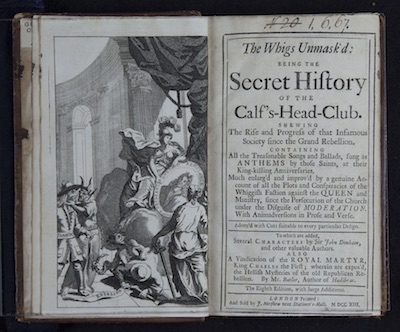
Figure 1a. Edward WardWhigs Unmasked, or an Address to the People of Great Britain . London, 1713.
DA430 .W21w
Ward was a humorist and poet who used verse to present observations on the events of his day in England, including commentary on the class structure of British life. The Whigs supported constitutional–as opposed to absolute–monarchy.
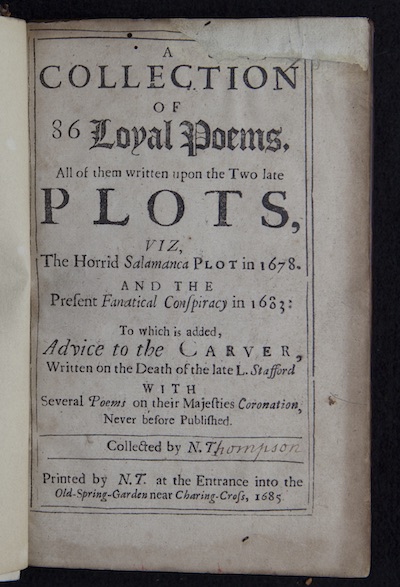
Figure 1b. Nathaniel Thompson, A Collection of 86 loyal poems, all of them written upon the two late plots, vis. The horrid Salamanca plot in 1678, and the present fanatical conspiracy in 1683 [...]. London, 1685.
PR1213 .T375c
This collection of poems was written in relation to the “Salamanca conspiracy” and other political events. Some are written in the voice of King Charles I. Though not printed in the broadsheet format, they are an example of political verse and print commentary on events.
↩
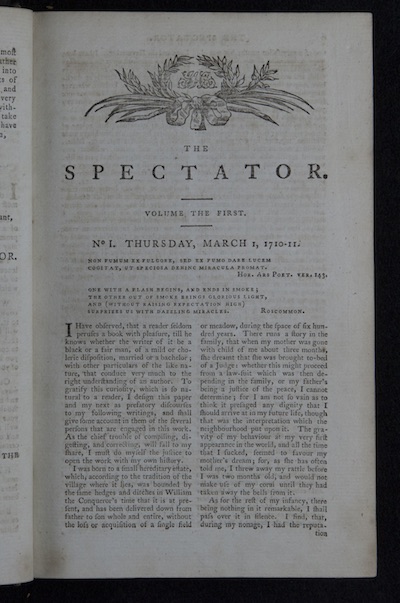
Figure 2a. Joseph Addison and Richard Steele,
The Spectator. Harrison’s British “Classicks” series, 1793 reprint.
PR1101 .H24 1790z
The sheaf of palms and wreath of laurels encircling the initials branding this as part of the “Harrison Classics” shows the esteem in which The Spectator was held for generations. Remarkably, this publication appeared daily for 555 numbers and had a readership of over three thousand people, including a large proportion of women. The journal circulated in tea rooms and coffee houses as well as to individual households.
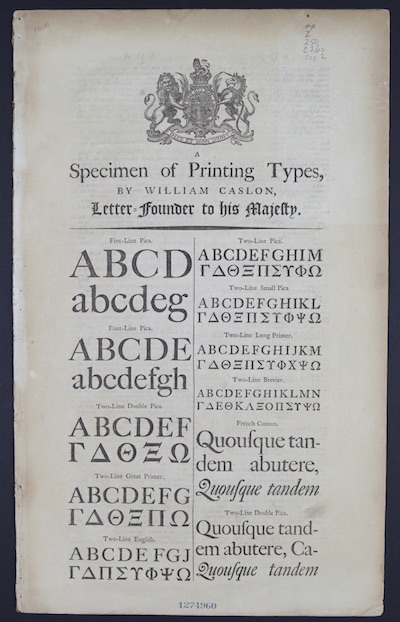
Figure 2b. William Caslon Specimen Sheet.
**Z250 .C26s
The text of The Spectator was composed in Caslon, one of the most robust and widely used British typefaces of the 18th century. Long beholden to Dutch typefounders, the British printing industry quickly absorbed the versatile designs of the prolific William Caslon. These fonts followed the course of British Empire and were distributed throughout the far flung Colonies, including those in North America. Caslon’s original specimens were first issued in the 1720s. Caslon died in 1766, but the foundry continued under the supervision of his sons.
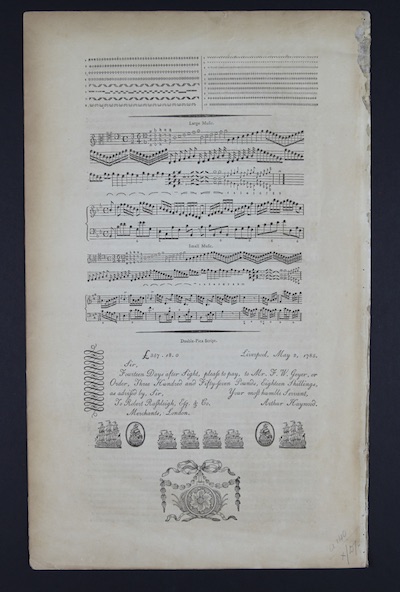
Figure 2c. William Caslon Specimen Sheet.
**Z250 .C26s
Printing sheet music was a challenge, as the combination of notes, staffs, and other features multipled the number of elements required in a font. Early music printing consisted of “double-strike” printing, the overprinting of notes on a staff, but Caslon’s fonts represented each element individually, as can be seen on close examination of this sheet, where the joins between the lines of the musical staff are evident.
↩
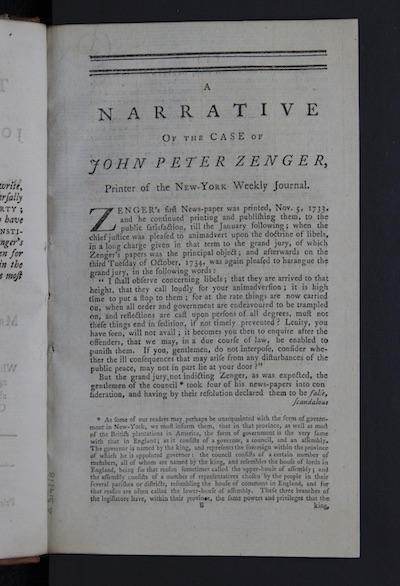
Figure 3.
Peter Zenger, Boston News-Letter. 1768.
K39 .Z43t
Peter Zenger’s acquittal in 1734 of a case where he was accused of libel by the Governor of New York became a landmark decision in freedom of the press. This account of the trial was printed thirty-four years later.
↩
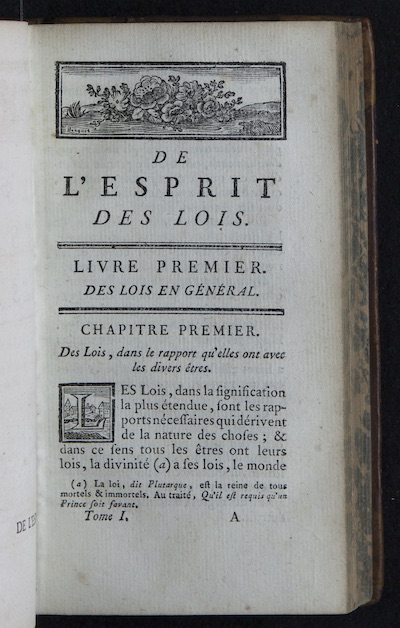
Figure 4.
Baron de Montesquieu, Oeuvres. 1772.
Z233.M3 M76o 1772r
Initially published anonymously in 1748, “The Spirit of the Laws” was a treatise that had a profound influence on the formulation of the American political system. The work outlined principles of separation of powers, preservation of liberty, and relations between citizens and their governments. The small size and elegant typography are typical of the 18th century.
↩
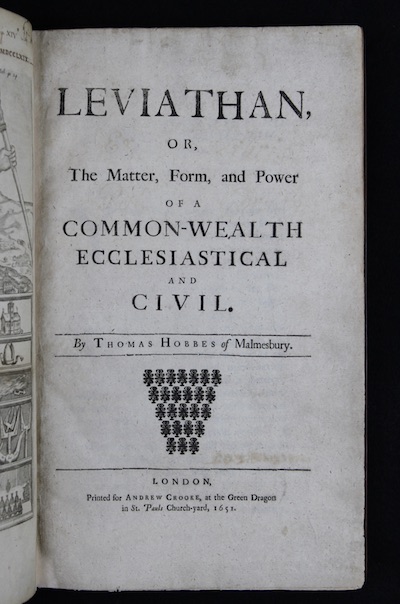
Figure 5.
Thomas Hobbes, Leviathan.
*JC153 .H651 1651c
Thomas Hobbes’s treatise, originally published in 1651, outlined the concept of the “social contract” on which American democracy was based. This concept assumes that the citizens transfer certain rights to the State in exchange for benefits within the Commonwealth to which they are loyal. Hobbes envisioned a monarchical government, but one constrained by laws that would raise society above conditions of “brute” nature.
↩

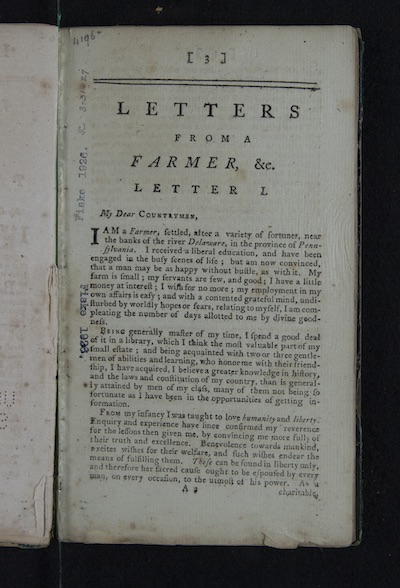
Figures 6a and 6b.
John Dickinson, Letters from a Farmer in Pennsylvania . 1767.
E211 .D56
John Dickinson’s Letters from a Farmer in Pennsylvania was initially issued in a series of publications that were deeply influential in forming public opinion in favor of the War of Independence. By taking on the voice of a farmer, the author, who was a lawyer and legislator, argued against the legitimacy of certain taxes being levied on the Colonies. This collection of the original twelve letters, published in Boston in 1768, is a testament to their popularity.
↩
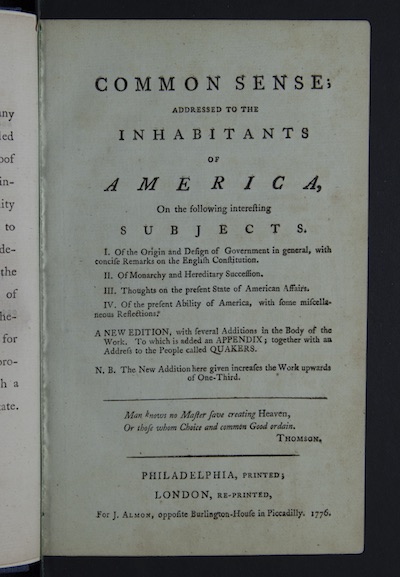
Figure 7.
Thomas Paine, Common Sense. 1776.
E211 .P16c 1776
Few pamphlets have had so consequential an impact as Thomas Paine’s Common Sense. Originally issued in 1775-76, it appears here in a new edition in 1776, outlining the fundamental principles of the Declaration of Independence in terms that questioned the moral legitimacy of monarchy. The work sold in the hundreds of thousands of copies within the first year and was widely circulated.
↩
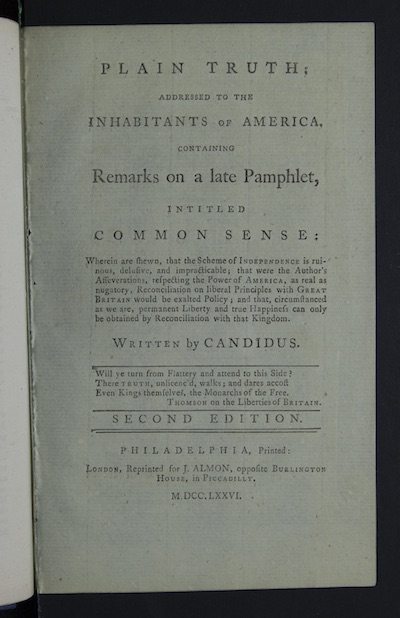
Figure 8.
John Chalmers aka. Candidus, Plain Truth. 1776.
E211 .P16c 1776
Written by a Loyalist from Maryland, this pamphlet adopted the title first used by Paine for Common Sense, but the text on its title page makes clear that this tract is in opposition to Independence, which it characterizes as “ruinous, delusive, and impracticable.” He argues for “Reconciliation” with Britain. The copy in UCLA's Young Research Library, Special Collections, is bound into the same volume as Paine’s work.
↩
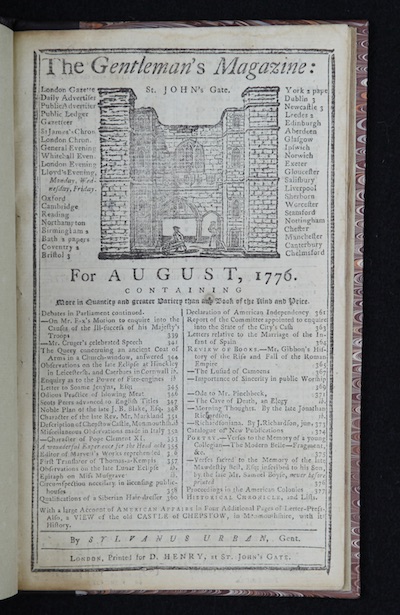
Figures 9a and 9b.
Gentleman’s Magazine. Britain, 1776.
E221 .G28 1776
The first English publication of the Declaration of Independence, appeared in the August 1776 issue of this magazine. It is listed at the top of the right-hand column beginning on page 361. Other items in the same issue include a review of “Mr.Gibbon’s History of the Rise and Fall of the Roman Empire,” observations on a recent eclipse, a list of Scots Peers advanced to English Titles, considerations on “licensing public-houses” and a reflection on the “Qualifications of a Siberian Hairdresser.”
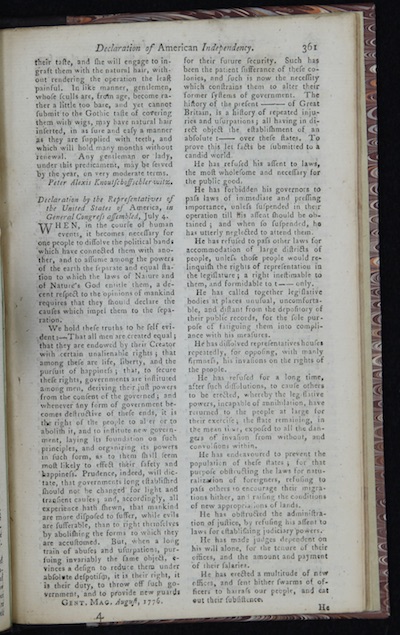
Declaration of Independence. 1776.
E221 .G28 1776
The Declaration of Indepence in its inconspicuous presentation within the pages of the Gentleman’s Magazine.
↩
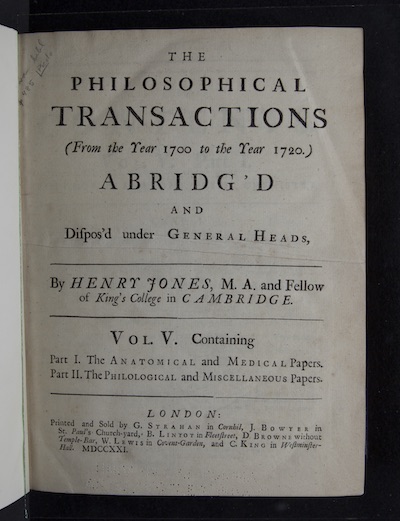
Figure 10.
Henry Jones, Editor, Philosophical Transactions. 1721.
No call number
A volume of the proceedings of the Royal Society, focused on matters of “Zoology, Anatomy, Physic and Chymistry,” includes studies by various authors on matters as varied as the “Description of the Wood-pecker’s Tongue,” “Anatomy of the Heart of Land-Tortoises,” “ The Silk of Spiders,” and “ A Monstrous Calf.” Papers omitted are also given mention.
↩

Figure 11.
Giambattista Bodoni, Manuale Tipografico. 1774.
* Z233.B6 B63p
This remarkable volume of type specimens, produced by one of the most important printers and designers of the 18th century, contains samples of fonts in a wide range of ancient and modern languages including: Hebrew, Greek, Rabbinic, Syriac, Chaldaic, Palmyrene, Turkish, Hebrew with points, Coptic, Syro-Estranghela, Samaritain, Arabic, Phonecian, Persian, Greek, German, Aegyptian, Armenian, Etruscan, and Punic. Punic, shown here, is an extinct form of the Phoenician alphabet spread throughout the Mediterranean. It is found in inscriptions in and around Carthage, on the North African coast.
↩
All images are from book in the Charles E. Young Research Library at UCLA, unless otherwise noted.